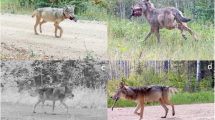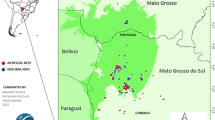Abstract
Simocephalus vetulus was reared at five different densities, 1, 20, 40, 60 and 80 ind. (20 ml)-1, to examine the effects of population density on growth and reproduction under a sufficient food supply using a flow-through technique. The carapace length of S. vetulus older than six-days, and the cumulative number of neonates produced decreased with increasing population density over 40 ind. (20 ml)-1. This result demonstrates that both growth and reproduction of the animals are adversely affected by crowding even under a sufficient food supply, except for juvenile growth. Although the reduction of growth rate in adult stages could be interpreted as resulting from a decrease in available food by depression of feeding rate due to crowding, reduction of the clutch size was simply caused by reduction of their parent size as population density increased. Maturation age of the animals was the same at each density, but body size at maturation declined with increasing density. This response may be different from that of food limited animals, because delayed maturation determining body weight has been shown in food-limited conditions. Additionally, body size and weight of the neonates released at the highest density were greater than those at the lowest one. Reproductive investment was also greater at the highest density. This suggests that the crowded animals may allocate more energy to reproduction, then reduce their own body size, and finally produce large offspring, to provide for severe future food conditions due to crowding.
Similar content being viewed by others
References
Birge, E. A., 1897. Plankton studies on Lake Mendota. II. The Crustacea of the plankton in July 1894-December 1896. Trans. Wis. Acad. Sci. Arts Lett. 11: 274-448.
Boersma, M., 1995. The allocation of resources to reproduction in Daphnia galeata: Against odds? Ecology 76: 1251-1261.
Brendelberger, H., 1991. Filter mesh size of cladocerans predicts retention efficiency for bacteria. Limnol. Oceanogr. 36: 884-894.
Burns, C.W., 1995. Effects of crowding and different food levels on growth and reproductive investment of Daphnia. Oecologia 101: 234-244.
Byron, E. R., P. T. Whitman & C. R. Goldman, 1983. Observations of copepod swarms in Lake Tahoe. Limnol. Oceanogr. 28: 378-382.
Cassie, R. M., 1963. Microdistribution of plankton. Oceanogr. mar. Biol. annu. Rev. 1: 223-252.
Colebrook, J. M., 1960. Some observations of zooplankton swarms in Windermere. J. anim. Ecol. 29: 241-242.
Cushing, D. H., 1951. The vertical migration of planktonic Crustacea. Biol. Rev. 26: 158-192.
De Bernardi, R., P. Lacqua & E. Soldavini, 1978. Effects of temperature and food on developmental times and growth in Daphnia obtusa Kurz and Simocephalus vetulus (O.F.Müller) (Crustacea, Cladocera). Mem. Ist. ital. Idrobiol. 36: 171-191.
Dumont, H. J., 1967. A five day study of patchiness in Bosmina coregoni Baird in a shallow eutrophic lake. Mem. Ist. ital. Idrobiol. 22: 81-103.
Dumont, H. J., I. Vande-Velde & S. Dumont, 1975. The dry weight estimate of biomass in a selection of Cladocera, Copepoda and Rotifera from the plankton, periphyton and benthos of continental waters. Oecologia 19: 75-97.
Ebert, D., 1993. The trade-off between offspring size and number in Daphnia magna: the influence of genetic, environmental and maternal effects. Arch. Hydrobiol. Suppl. 90: 453-473.
Folt, C. & C. R. Goldman, 1981. Allelopathy between zooplankton: a mechanism for interference competition. Science 213: 1133-1135.
Frank, P. W., C. D. Boll & R. W. Kelly, 1957. Vital statistics of laboratory cultures of Daphnia pulex Degeer as related to density. Physiol. Zool. 30: 287-305.
Glazier, D. S., 1992. Effects of food, genotype, and maternal size and age on offspring investment in Daphnia magna. Ecology 73: 910-926.
Gliwicz, Z. M. & C. Guisande, 1992. Family planning in Daphnia: resistance to starvation in offspring born to mothers grown at different food levels. Oecologia 91: 463-467.
Goss, L. B. & D. L. Bunting, 1980. Temperature effects on zooplankton respiration. Comp. Biochem. Physiol. 66A: 651-658.
Guisande, C., 1993. Reproductive strategy as population density varies in Daphnia magna (Cladocera). Freshwat. Biol. 29: 463-467.
Guisande, C. & Z. M. Gliwicz, 1992. Egg size and clutch size in two Daphnia species grown at different food levels. J. Plankton Res. 14: 997-1007.
Hayward, R. S. & D. N. Gallup, 1976. Feeding, flitering and assimilation in Daphnia schoedleri Sars as affected by environmental conditions. Arch. Hydrobiol. 77: 139-163.
Hebert, P. D. N., 1978. The population biology of Daphnia (Crustacea, Daphnidae). Biol. Rev. 53: 387-426.
Helgen, J. C., 1987. Feeding rate inhibition in crowded Daphnia pulex. Hydrobiologia 154: 113-119.
Hobæ k, A. & P. Larsson, 1990. Sex determination in Daphnia magna. Ecology 71: 2255-2268.
Kerfoot, W. C., W. R. DeMott & C. Levitan, 1985. Nonlinearities in competitive interactions: Component variables or system response? Ecology 66: 959-965.
Kimmerer, W. J., 1984. Spatial and temporal variability in egg production rates of the calanoid copepod Acrocalanus inermis. Mar. Biol. 78: 165-169.
Larsson, P. & S. Dodson, 1993. Invited review. Chemical communication in planktonic animals. Arch. Hydrobiol. 129: 129-155.
Matveev, V., 1993. An investigation of allelopathic effects of Daphnia. Freshwat. Biol. 29: 99-105.
Miralto, A., A. Ianora, S. A. Poulet, G. Romano & M. Laabir, 1996. Is fecundity modefied by crowding in the copepod Centropages typicus. J. Plankton Res. 18: 1033-1040.
Motoda, S., 1950. Hokkaido kosho-shi. Sci. Rep. Hokkaido Fish Hatchery 5: 1-96 (In Japanese).
Nishikawa, J. & S. Ban, 1998. Effect of high population density on growth and reproduction of Daphnia pulex DeGeer. Plankton Biol. Ecol. 45: 55-60.
Razouls, S., 1972. Influence des conditions experimentales sur le taux respiratoire des copepodes planctoniques. J. exp. mar. Biol. Ecol. 9: 145-153.
Riessen, H. P. & W. G. Sprules, 1990. Demographic costs of antipredator defenses in Daphnia pulex. Ecology 71: 1536-1546.
Satomi, M. & L. R. Pomeroy, 1965. Respiration and phosphorus excretion in some marine population. Ecology 46: 877-881.
Seitz, A., 1984. Are there allelopathic interactions in zooplankton? Laboratory experiments with Daphnia. Oecologia 62: 94-96.
Stemberger, R. S., 1981. A general approach to the culture of planktonic rotifers. Can. J. Fish. aquat. Sci. 38: 721-724.
Taylor, B. E., 1985. Effects of food limitation on growth and reproduction of Daphnia. Arch. Hydrobiol. Beih. Ergebn. Limnol. 21: 285-296.
Tessier, A. J. & N. L. Consolatti, 1991. Resource quantity and offspring quality in Daphnia. Ecology 72: 468-478.
Urabe, J., 1988. Effect of food conditions on the net production of Daphnia galeata: Separate assessment of growth and reproduction. Bull. Plankton Soc. Japan 35: 159-174.
Urabe, J., 1991. Effect of food concentration on growth, reproduction and survivorship of Bosmina longirostris (Cladocera): an experimental study. Freshwat. Biol. 25: 1-8.
Walker, I., 1979. Mechanisms of density-dependent population regulation in the marine copepod Amphiascoides sp. (Harpacticoida). Mar. Ecol. Prog. Ser. 1: 209-221.
Williamson, C. E., N.M. Butler & L. Forcina, 1985. Food limitation in naupliar and adult Diaptomus pallidus. Limnol. Oceanogr. 30: 1283-1290.
Author information
Authors and Affiliations
Rights and permissions
About this article
Cite this article
Lee, Hw., Ban, S. Effect of crowding on growth and reproduction of Simocephalus vetulus O.F. Müller. Hydrobiologia 391, 135–145 (1998). https://doi.org/10.1023/A:1003529109779
Issue Date:
DOI: https://doi.org/10.1023/A:1003529109779




